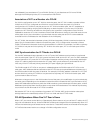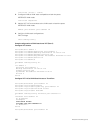request for 20.1.1.1 reaches node 1, node 1 will not perform the ARP request for 20.1.1.2. Proxy ARP is
supported only for the IP address belongs to the received interface IP network. Proxy ARP is not
supported if the ARP requested IP address is different from the received interface IP subnet. For example,
if VLAN 100 and 200 are configured on the VLT peers, and if the VLAN 100 IP address is configured as
10.1.1.0/24 and the VLAN 200 IP address is configured as 20.1.1.0/24, the proxy ARP is not performed if
the VLT node receives an ARP request for 20.1.1.0/24 on VLAN 100.
Working of Proxy ARP for VLT Peer Nodes
Proxy ARP is enabled only when peer routing is enabled on both the VLT peers. If peer routing is disabled
on one of the VLT peers, proxy ARP is not performed when the ICL link goes down. Proxy ARP is
performed only when the VLT peer's MAC address is installed in the database. Proxy ARP is stopped when
the VLT peer's MAC address is removed from the ARP database because of the peer routing timer expiry.
The source hardware address in the ARP response contains the VLT peer MAC address. Proxy ARP is
supported for both unicast and broadcast ARP requests. Control packets, other than ARP requests
destined for the VLT peers that reach the undesired and incorrect VLT node, are dropped if the ICL link is
down. Further processing is not done on these control packets. The VLT node does not perform any
action if it receives gratuitous ARP requests for the VLT peer IP address. Proxy ARP is also supported on
secondary VLANs. When the ICL link or peer is down, and the ARP request for a private VLAN IP address
reaches the wrong peer, then the wrong peer responds to the ARP request with the peer MAC address.
The IP address of the VLT node VLAN interface is synchronized with the VLT peer over ICL when the VLT
peers are up. Whenever an IP address is added or deleted, this updated information is synchronized with
the VLT peer. IP address synchronization occurs regardless of the VLAN administrative state. IP address
addition and deletion serve as the trigger events for synchronization. When a VLAN state is down, the VLT
peer might perform a proxy ARP operation for the IP addresses of that VLAN interface.
VLT nodes start performing Proxy ARP when the ICL link goes down. When the VLT peer comes up, proxy
ARP will be stopped for the peer VLT IP addresses. When the peer node is rebooted, the IP address
synchronized with the peer is not flushed. Peer down events cause the proxy ARP to commence.
When a VLT node detects peer up, it will not perform proxy ARP for the peer IP addresses. IP address
synchronization occurs again between the VLT peers.
Proxy ARP is enabled only if peer routing is enabled on both the VLT peers. If you disable peer routing by
using the no peer-routingcommand in VLT DOMAIN node, a notification is sent to the VLT peer to
disable the proxy ARP. If peer routing is disabled when ICL link is down, a notification is not sent to the
VLT peer and in such a case, the VLT peer does not disable the proxy ARP operation.
When the VLT domain is removed on one of the VLT nodes, the peer routing configuration removal will
be notified to the peer. In this case VLT peer node disables the proxy ARP. When the ICL link is removed
on one of the VLT nodes by using the no peer-link command, the ICL down event is triggered on the
other VLT node, which in turn starts the proxy ARP application. The VLT node, where the ICL link is
deleted, flushes the peer IP addresses and does not perform proxy ARP for the additional LAG hashed
ARP requests.
988
Virtual Link Trunking (VLT)


















